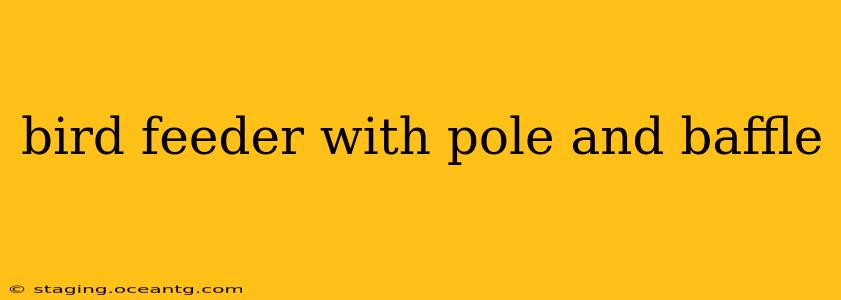Attracting birds to your backyard is a rewarding experience. A well-chosen bird feeder with a pole and baffle can significantly increase your chances of success, providing a safe and convenient feeding station for your feathered friends. This guide explores the key features to consider when selecting the perfect setup, answering common questions along the way.
What is a Baffle on a Bird Feeder Pole?
A baffle is a crucial component of any bird feeder pole system. It's a wide, typically dome-shaped or cone-shaped, disc placed above the feeder. Its primary purpose is to prevent squirrels and other unwanted critters from climbing the pole to raid the feeder. Without a baffle, your meticulously filled feeder might become a squirrel buffet before the birds even get a chance! Baffles come in various materials, including metal, plastic, and even coated wire.
What are the Different Types of Bird Feeder Poles?
Bird feeder poles vary in material, height, and design. Common options include:
- Metal Poles: Durable and long-lasting, metal poles (often steel or aluminum) are resistant to weathering and provide sturdy support. They're ideal for heavier feeders and withstand strong winds.
- Wood Poles: Offering a more natural aesthetic, wooden poles can be aesthetically pleasing, but they require more maintenance to prevent rot and insect damage. They may not be as durable as metal options.
- Plastic Poles: Generally more affordable, plastic poles are lightweight and easy to install. However, they might not be as robust or weather-resistant as metal or wood.
How High Should My Bird Feeder Pole Be?
The ideal height for your bird feeder pole depends on several factors, including your yard's landscape, the presence of predators, and the type of birds you wish to attract. Generally, you want to place the feeder high enough to deter ground predators like cats and raccoons, but low enough for you to easily fill and clean it. A height of 5-8 feet is a good starting point for most situations. Consider placing it near shrubs or trees for added bird protection.
What Kind of Bird Feeder is Best for a Pole?
The best type of feeder for a pole system depends on the birds you want to attract and the types of seeds you plan to offer. Some popular options include:
- Tube Feeders: These feeders hold multiple feeding ports, perfect for smaller birds like finches and chickadees.
- Hopper Feeders: Larger capacity feeders ideal for larger flocks and offering various seed types.
- Suet Feeders: These feeders hold high-energy suet cakes, a favorite of woodpeckers and other birds during colder months.
Remember to choose a feeder that's appropriately sized and weighted for your chosen pole.
What Materials are Best for Baffles?
Baffles are typically made from metal, plastic, or coated wire. Metal baffles offer superior durability and squirrel resistance, while plastic baffles are generally more affordable but might not be as effective against determined squirrels. Consider the squirrel population in your area when making your choice. A smooth, slippery surface is crucial for preventing squirrels from climbing.
How Do I Prevent Squirrels from Getting to My Bird Feeder?
While a baffle is your first line of defense, several other strategies can help keep squirrels away:
- Choose a feeder with squirrel-resistant features: Some feeders have features designed to make it difficult for squirrels to access the seed.
- Use different types of feeders: Squirrels may not be attracted to all types of feeders.
- Use spicy or bitter seed coatings: These can deter squirrels without harming birds.
- Regularly clean your feeder: This prevents the buildup of spilled seeds that attract squirrels.
How Often Should I Clean My Bird Feeder?
Regular cleaning is essential to maintain a healthy environment for birds and prevent the spread of disease. Ideally, you should clean your feeder at least once a month, or more often during warm, humid weather. Remove old seed, wash the feeder with soapy water, and rinse thoroughly before refilling.
By carefully selecting your bird feeder, pole, and baffle, and by following proper maintenance practices, you can create a welcoming and safe haven for a variety of birds in your backyard. Remember to consider your local bird species and the challenges posed by squirrels and other wildlife when making your choices.
